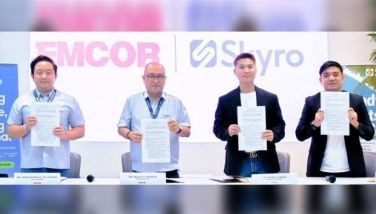An alternative to the vale practice
July 28, 2003 | 12:00am
Many entrepreneurs who schedule weekly payrolls know that they have to be ready with vale money on Wednesday. Vale refers to the employee’s request for cash advance in between payroll dates and which amount is deductible from the forthcoming salary. In some cases, an employee with vale would be absent without leave and just disappear, leaving the entrepreneur with a receivable/collectible account. This is what we call the "vale, vale, then di na bale" practice.
The real issue here is: Why does an employee need an advance in between payrolls? Why can’t he/she just wait for the Saturday payday?
One solution to this predicament would be the payment of daily wages. However, to prepare payroll on a daily basis is impractical. Clearly, this is a problem rooted in the sheer absence of employee savings that could buffer the need for funds in between paydays.
Can one stop the practice by simply closing the vale window? This solution is just as impractical as doing the payroll every day. We must recognize that the vale issue is a function of an employee’s lack of savings. Obviously, the Saturday take-home pay is just not enough to meet her/her needs by Wednesday. Such a situation even worsens come school enrollment time when salary advances must be resorted to for tuition and related expenses.
Depending on the amounts involved, these advances are deductible from the next payroll or over a period of time. Again, this is reflective of the lack of savings. And one can save only if income is higher than expenses. While the other solution is to increase income, this may lead to the firm’s becoming uncompetitive.
So, what can the entrepreneur do? Live with the practice? Make a difference?
To pursue the latter means the entrepreneur will have to address the root issue of lack of savings. Many organizations have used the age-old paluwagan system, which, in a way, forces a savings mechanism for the benefit of cooperating employees.
One of our ME student-entrepreneurs came up with an innovative response to the vale practice. The idea surfaced just after he had dished out a large sum in the form of cash advances or vale to fund his employees’ education-related expenses. He thought of a way to increase the income of his employees without giving a salary increase.
At first, it sounded like an oxymoron. But as the student-entrepreneur explained it, the idea turned out to be quite feasible. He picked up the concept from one of the case materials used in the ME Program where the concept of a "corporative" was used.
A corporative is a corporation by legal status but a cooperative in operations. The ownership structure is a function of paid-up capital put in, while the election of board members and officers is a function of shareholdings. This is unlike a cooperative where one person holds one vote.
Operating like a cooperative, the corporative is a social enterprise that exists to improve the quality of life of the owners, individually and collectively.
The student-entrepreneur’s idea was to set up a company that is jointly owned by his company and the individual employees, with the company initially funding the capital requirements. The employees’ shares will eventually be owned by them when the dividends of the shares can pay off the advances made by the student-entrepreneur. This means that the employee will not yet get dividends until the capital advanced on their behalf is paid up by initial dividends. Alternatively, employees who can put in capital are welcome and can immediately share in the dividends. The object is to create an enterprise that creates a new source of income for each employee.
It is interesting to note that the total initial capital outlay of this social enterprise approximately equals the total amount of advances made by the employees before the 2003-2004 school year started.
The student-entrepreneur has kept a controlling share in the corporative. This ensures that the social enterprise does not lose its original vision, mission, and objectives. The controlling share has an oversight function on the operations.
The type of operations of the enterprise involves two major undertakings: the operation of the company canteen and a micro-finance lending facility. In both cases, the client system is initially the employees. In order to minimize the cost of operations, only the people involved in the canteen operations are to be hired on a full-time basis. Other functions like accounting and other administrative functions are to be done by individual owners who will be paid for their part-time responsibility.
The operating strategy and choice of business is designed for good and certain returns. As such, dividends are definite and the issue is only its amount. The system can be designed to give dividends quarterly, monthly, or better yet, timed when there are cash requirements such as school opening and Christmas.
In the long haul, the challenge lies in making sure that this idea works. With a new source of income for each employee, the reality of savings would serve to discourage the vale practice. and, at best, to obliterate the system.
(Alejandrino Ferreria is the dean of the Asian Center for Entrepreneurship of the Asian Institute of Management. For further comments and inquiries, you may contact him at: [email protected]. Published "Entrepreneur’s Helpline" columns can be viewed on the AIM website at http//: www.aim.edu.ph).
The real issue here is: Why does an employee need an advance in between payrolls? Why can’t he/she just wait for the Saturday payday?
One solution to this predicament would be the payment of daily wages. However, to prepare payroll on a daily basis is impractical. Clearly, this is a problem rooted in the sheer absence of employee savings that could buffer the need for funds in between paydays.
Can one stop the practice by simply closing the vale window? This solution is just as impractical as doing the payroll every day. We must recognize that the vale issue is a function of an employee’s lack of savings. Obviously, the Saturday take-home pay is just not enough to meet her/her needs by Wednesday. Such a situation even worsens come school enrollment time when salary advances must be resorted to for tuition and related expenses.
Depending on the amounts involved, these advances are deductible from the next payroll or over a period of time. Again, this is reflective of the lack of savings. And one can save only if income is higher than expenses. While the other solution is to increase income, this may lead to the firm’s becoming uncompetitive.
To pursue the latter means the entrepreneur will have to address the root issue of lack of savings. Many organizations have used the age-old paluwagan system, which, in a way, forces a savings mechanism for the benefit of cooperating employees.
One of our ME student-entrepreneurs came up with an innovative response to the vale practice. The idea surfaced just after he had dished out a large sum in the form of cash advances or vale to fund his employees’ education-related expenses. He thought of a way to increase the income of his employees without giving a salary increase.
At first, it sounded like an oxymoron. But as the student-entrepreneur explained it, the idea turned out to be quite feasible. He picked up the concept from one of the case materials used in the ME Program where the concept of a "corporative" was used.
A corporative is a corporation by legal status but a cooperative in operations. The ownership structure is a function of paid-up capital put in, while the election of board members and officers is a function of shareholdings. This is unlike a cooperative where one person holds one vote.
Operating like a cooperative, the corporative is a social enterprise that exists to improve the quality of life of the owners, individually and collectively.
It is interesting to note that the total initial capital outlay of this social enterprise approximately equals the total amount of advances made by the employees before the 2003-2004 school year started.
The student-entrepreneur has kept a controlling share in the corporative. This ensures that the social enterprise does not lose its original vision, mission, and objectives. The controlling share has an oversight function on the operations.
The type of operations of the enterprise involves two major undertakings: the operation of the company canteen and a micro-finance lending facility. In both cases, the client system is initially the employees. In order to minimize the cost of operations, only the people involved in the canteen operations are to be hired on a full-time basis. Other functions like accounting and other administrative functions are to be done by individual owners who will be paid for their part-time responsibility.
The operating strategy and choice of business is designed for good and certain returns. As such, dividends are definite and the issue is only its amount. The system can be designed to give dividends quarterly, monthly, or better yet, timed when there are cash requirements such as school opening and Christmas.
In the long haul, the challenge lies in making sure that this idea works. With a new source of income for each employee, the reality of savings would serve to discourage the vale practice. and, at best, to obliterate the system.
(Alejandrino Ferreria is the dean of the Asian Center for Entrepreneurship of the Asian Institute of Management. For further comments and inquiries, you may contact him at: [email protected]. Published "Entrepreneur’s Helpline" columns can be viewed on the AIM website at http//: www.aim.edu.ph).
BrandSpace Articles
<
>
- Latest
Latest
Latest
January 13, 2025 - 10:45am
January 13, 2025 - 10:45am
January 10, 2025 - 9:30am
January 10, 2025 - 9:30am
January 7, 2025 - 9:00am
January 7, 2025 - 9:00am
January 6, 2025 - 10:45am
January 6, 2025 - 10:45am
January 2, 2025 - 2:00pm
January 2, 2025 - 2:00pm
Recommended

























